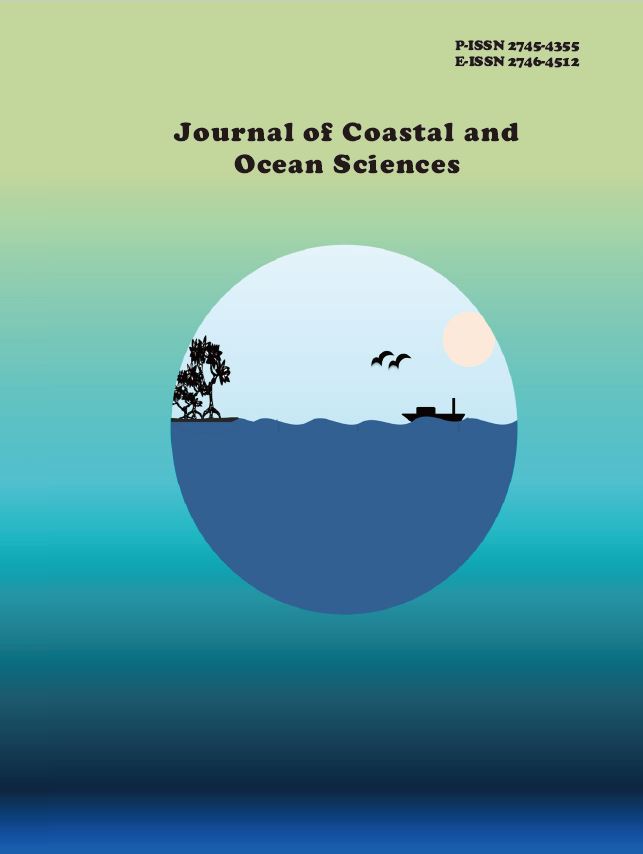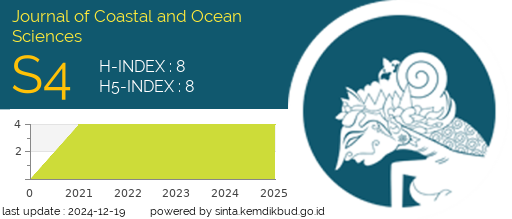Biodegradability of Proteolytic Bacteria in Mangrove Ecosystems
DOI:
https://doi.org/10.31258/Keywords:
Biodegradation Growth Proteolytic Bacteria Protease Enzyme Dissolved ProteinAbstract
The purpose of this study was to awareness the optimal time for the growth of proteolytic bacteria in producing the protease enzyme and determine the effectiveness of the protease enzyme from proteolytic bacteria in degrading mangrove litter. The method used was the experimental method by using two proteolytic bacteria isolates, namely Bacillus manliponensis (K6) and Bacillus toyonensis (K20). This method used one treatment for each proteolytic bacterial isolate, namely the addition of different extract containing protease enzyme (0%, 25%, and 50%) with three replications. Measurement of bacterial growth was carried out every 6 hours for 24 hours using Total Plate Count (TPC) and spectrophotometric method. B. manliponensis and B. toyonensis have enzyme activity as indicate by the presence of a clear zone on Zobell Marine Agar 2216 and skim milk 1%. The growth bacteria based on the TPC measurement was directly proportional to the spectrophotometric measurement results. The highest bacterial count was (1.39 x 108 CFU's/ml) K6 bacteria and (1.52 x 108 CFU's/ml) K20 bacteria. The results of the measurement of cell growth in the spectrophotometric method occurred at the 6th hour, namely 10.36 x 108 CFU's/ml (K6 bacteria) and 10.97 x 108 CFU's/ml (K20 bacteria). The optimum time of the protease enzyme occurred at 6 hours, which was 0.0258 mg/ml (K6 bacteria) and 0.0262 mg/ml (K20 bacteria). The highest dissolved protein content was obtained at the 50% dose of 0.054 mg/ml (K6 bacteria) and 0.055 mg/ml (K20 bacteria), while the lowest was at 0%, namely 0.050 mg/ml (K6 bacteria) and 0.051 mg/ml (K20 bacteria).
Downloads
References
DALYNN, Biological. (2014). McFarland Standard. Canada: DALYNN Biological.
Effendi, I. (2020). Metode Isolasi dan Identifikasi Bakteri. Oceanum Press. Pekanbaru.
Imron, M.F. dan I.F. Purwanti. (2016). Uji Kemampuan Bakteri Azotobacter S8 dan Bacillus subtilis untuk Menyisihkan Trivalent Chromium (Cr3+) pada Limbah Cair. Jurnal Teknik ITS 5(1):F4–F10
Madigan, M.T., J.M. Martinko. dan J. Parker. (2009). Biology of Microorganism. 9th Edition. Prentice Hall International, Inc. New Jersey.
Murray, R.K., D.K. Granner, A.P. Mayes, and V.W. Rodwell. (2003). Biokimia Harper. Penerbit Buku Kedokteran EGC, Ed 25, Jakarta.
Naibaho, R. F., Yunasfi, dan A. Suryanti. (2015). Laju Dekomposisi Serasah Daun Avicennia marina dan Kontribusinya terhadap Nutrisi di Perairan Pantai Serambi Deli Kecamatan Pantai Labu. Jurnal Aquacoastmarine 7(2): 152-164.
Olii, A.H., Muhlis, dan Sayuti. (2015). Ekosistem Mangrove Perairan Teluk Kwandang Kabupaten Gorontalo Utara. Jurnal Perikanan dan Kelautan, 20(2); 49-55
Syarial., W. Syahrian, dan T. Heriyanto. (2018). Inventarisasi dan Pola Penyebaran Regenerasi Alami Semai Mangrove Sejati di Utara Indonesia. Jurnal Perikanan dan Kelautan, 23(1): 39-46
Tyas, D.E., N. Widyorini dan A. Solichin. (2018). Perbedaan Jumlah Bakteri dalam Sedimen pada Kawasan Bermangrove dan Tidak Bermangrove di Perairan Desa Bedono, Demak. Journal of Maquares, 7(2):189-196.
Widhyastuti, N. dan R.M. Dewi. (2001). Isolasi Bakteri Proteolitik dan Optimasi Produksi Protease. Laporan Teknik Proyek Inventarisasi dan Karakterisasi Sumberdaya Hayati. Pusat Penelitian Biologi. LIPI
Witono, Y., M. Maryanto, I. Taruna, A.D. Masahid, dan K. Cahyaningti. (2020). Aktivitas Antioksidan Hidrolisat Protein Ikan Wader (Rasbora jacobsoni) dari Hidrolisis oleh Enzim Calotropin dan Papain. Jurnal Agroteknologi 14(1):1-8
Yunita, R., T.T., Nugroho, dan F. Puspita. (2015). Uji Aktivitas Enzim Protease dari Isolat Bacillus sp. Galur Lokal Riau. JOMP FMIPA, 1:116-122.
Yunita, S.P. (2012). Skrining dan Uji Aktivitas Enzim Protease Bakteri dari Limbah Rumah Pemotongan Hewan. Skripsi. Fakultas Sains dan Teknologi. Universitas Airlangga. Surabaya.
Zebua, A.B.P., Nursyirwani, dan Feliatra. (2020). Molecular Identification of Proteolitic Bacteria from Mangrove Sediment in Dumai Marine Station. Asian Journal of Aquatic Sciences, 3(2): 179-188






